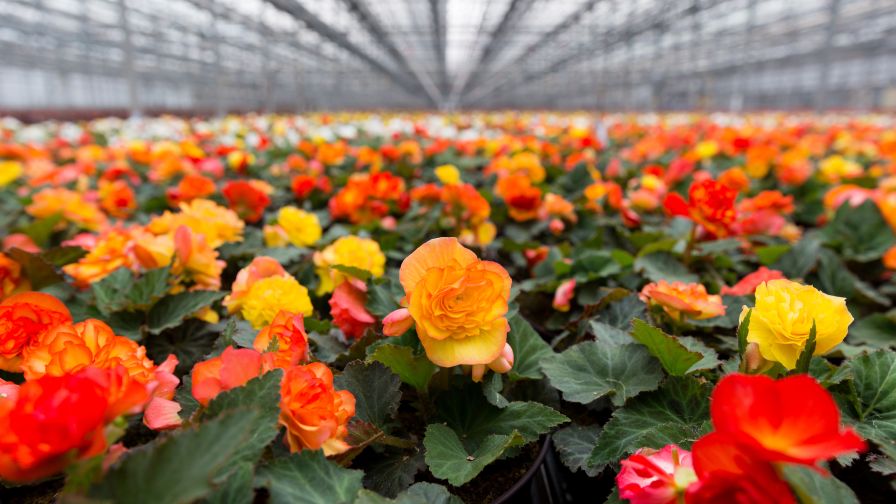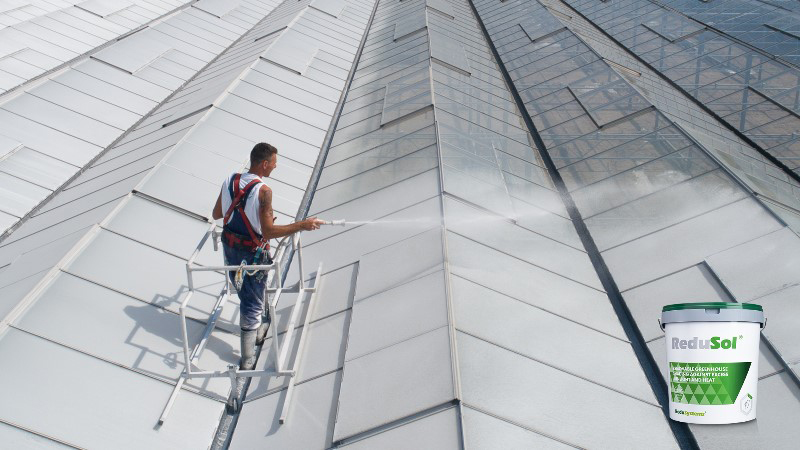Stress Management Techniques for Begonias in the Greenhouse

At the end of the growing season, increasing stress by reducing moisture, light, and food promotes begonia flowering. Photos: Metrolina Greenhouses
The goal is a full, lush, blooming begonia to offer customers, but begonia growers face multiple challenges. There are thousands of cultivars and several important distinctions — wax vs. tuberous, for example, and no one recipe works perfectly for them all.
Experienced growers find manipulating stress levels is key to achieving begonia results that are on time, and at the correct size and stage. Improperly timed flowering can be a common problem. Flowering too early can lead to a smaller plant that hasn’t filled the container. Deadheading and removing dropped, spent blooms from the containers — and anything growing below them — creates more labor expense. Of course, flowering too late means a less marketable product.
Growers looking for a one-size-fits-all formula to apply across multiple begonia cultivars likely won’t find it. Ivan Tchakarov is the Chief Horticulture Officer for Metrolina Greenhouses, one of the largest producers of ornamentals in the country with locations in North Carolina and South Carolina. Metrolina ships more than 1 million finished begonias each year in about 13 weeks.
“We use a different recipe for each type,” says Tchakarov, “and vary factors like day length, amount and duration of light, fertilizer, moisture levels, and use of bloom inhibitors.”
Whether you are growing a million begonias for sale or a few hundred, here are some ways to reduce or induce stress when growing and finishing begonias.
Day Length Varies with Cultivar
Many growers need to provide supplemental lighting to achieve satisfactory results with begonias. For northern greenhouses, day length isn’t long enough in the spring when these crops are started.
Day length needs vary widely based on the type of begonia. For tuberous varieties, a day length of less than 12 hours triggers tuber formation, diverting energy from vegetative growth and flowering. Supplemental lighting can prevent these plants from entering dormancy.
Brad Donahue, one of the owners at North Carolina Farms, says Reiger begonias are the easiest type to control flowering using light duration. Reigers will put on vegetative growth under long days, and flowering is triggered by short days.
At Metrolina Greenhouses, Tchakarov uses day extension lighting (18 hours) for all cultivars of begonias during the first and second stages of plug production. Providing more light is an effective way to reduce stress and increase vegetative growth by building more carbohydrates. For most begonias, he recommends using supplemental lighting, when needed, to achieve a daily light integral (DLI) of 9-12 moles per day. Less light (more stress) can cause the plants to flower earlier than desired.
When the plants have nearly reached the appropriate size for their container, it’s time to introduce some stress and promote flowering. Growers can reduce day length to allow plants to go into the reproductive phase.

Metrolina ships more than 1 million finished begonias each year in about 13 weeks.
Nitrogen Promotes Growth
Higher nitrogen feeding will increase vegetative growth, but fibrous-rooted begonias can be susceptible to damage from too-high levels. Excess salt buildup for these plants can cause root damage and therefore reduce uptake of nutrients. Metrolina Greenhouses starts most begonias at 60-100ppm with a 17-5-17 NPK fertilizer. Once established, Tchakarov says they bump the rate up to 150ppm. He finds keeping electrical conductivity (EC) 0.5-1.0 is important early in the lifecycle to avoid burning the fine root hairs.
Once the begonias have reached the appropriate size for the container, it is time to induce flowering by providing shorter days and lowering the fertilizer concentration. Tchakarov advises dropping the EC and reducing fertilizer into the 60ppm range.
“If the plants are not sizing up, the opposite technique is used,” he says. “We are removing flowers and increasing the concentration of fertilizer to make up the specs.”
Vegetative growth also needs to be in the proper form — tall, leggy, or sparse stems aren’t attractive to customers. Donahue says they use a combination of pinching and plant growth regulators (PGRs) at North Carolina Farms, but cautions that some PGRs are incompatible with begonias. He uses Florel on young stock plants to promote lateral branching.
Moisture Management Is Key
Katie Winterstein is a begonia grower at Bob’s Market and Greenhouses in West Virginia, growing plugs and finished plants. To induce stress and promote flowering, Winterstein uses moisture management.
“A longer wet-dry cycle will stress the plant and cause it to flower,” she says.
Winterstein finds the longer dry period works well with wax begonias, with good bloom results in about two weeks. Nonstop and tuberous varieties can take a bit longer.
Tchakarov agrees and uses moisture management along with adjusting feed rates and light for a combined effect. When looking for vegetative growth, he keeps the plants at a 3-4 on the standard 1 through 5 moisture scale. To induce flowering, he lets moisture drop to around a 2 for a couple of days, then brings it back up, creating a longer wet/dry cycle and a lower moisture level.
Begonias like the heat, and trying to grow them too cold can be a source of stress and slow vegetative growth. Winterstein says their begonias are grown at 70ºF to 74ºF. It can be tempting to drop the temperature and save on some heating costs, but that is detrimental to begonia growth rates. Keeping temperatures warm reduces stress and increases vegetative growth.
“In general, keeping begonias happy will help keep them leaning toward vegetative growth,” Donahue says. “We want them well watered, warm, and well-fed.”
Lower stress by providing plenty of moisture, light, and food to encourage vegetative growth. Increase stress by restricting those factors to make the plant concentrate energy on reproduction — flowering.
“Keeping them lean at the end, stressing them, helps begonias to flower more,” says Tchakarov.
With a million begonias to get ready every spring, he’s got it wired.








